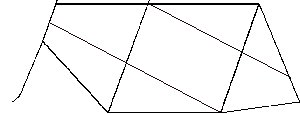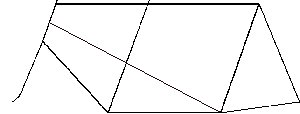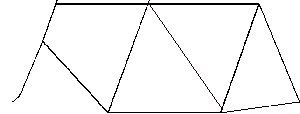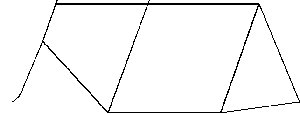




The steerer is the person who sits on the front and is mainly responsible for the control of the tandem. The steerer will of course claim to provide most of the power!
The Steerer also has control over the main brakes and the gears, and generally has to concentrate much more than the Stoker.
This is the person on the back of the tandem. Often this person has control of one of the brakes and is responsible for the navigation.
Riding on the back requires a fair degree of skill as leaning to one side will steer the tandem in that direction! Some confidence in the steerer is required when descending at 50 mph!
The difference in ride between a poor quality frame and a good quality frame is enormous. We have couples who have changed tandem and immediately gone from struggling to keep up to leaving everyone else behind! The main criteria is a stiff frame to ensure that all the energy goes into making the tandem move forward rather than bending the tubing!
The geometry of the forks is also crucial to making the steerers life easy - if it is wrong the slightest movement of the stoker will send the tandem off in an unplanned direction! Look for a steep head angle (73° or greater) and a good amount of bend in the forks (rake).
| Marathon | |
 |
This design offers a good compromise for touring between stiffness and comfort. Ideal if both riders have similar power outputs. Additional stays reinforce the rear triangle. |
| Double Marathon | |
 |
The strongest and stiffest design, very time consuming and difficult to manufacture and therefore expensive. Generally used for the largest and heaviest riders, racing or for extended heavy touring. The design is also used when light weight is required as very strong, stiff and light frames can be built. |
| Direct lateral | |
 |
Probably the easiest design to manufacture so very popular. Most "Off the peg" tandems are built to this design. It is also a good solution when the stoker is significantly lighter or less powerful than the steerer, and is particularly suitable for fitting kiddy cranks. |
| Double Diamond | |
 |
This design is basically two normal diamond frame solos joined together. The design is more flexible than the others which can make climbing hard work, however the flexibility does reduce the shock from bumps in the road. |
| Open Frame | |
 |
Not for serious use, but fine for short trips. Very flexible and heavy as strong tubes are required to compensate for the lack of bracing. |
There are many different theories about frame sizing, and general rules always find someone who is an exception and needs something different.
The following tables are a guide for conventional touring style frames and has been taken from Tony Olivers excellent book "Touring Bikes" (ISBN 1 85223 339 7) which should be on every serious cyclists bookshelf.
These dimensions are a guide and individual wants need to be taken into consideration. The sizing of the top tube refers of course to the front of the tandem. The distance from the stokers handlebar centreline to the stokers seat tube will be similar to the top tube length added to the stem length, however stokers do have a tendancy to sit up straighter.
|
|
Note the frame size refers to the seat tube length, and is measured from the centre of the bottom bracket to the top of the top tube. Continental frames are measured from the centre of the bottom bracket to the centre line of the top tube, and mountain bike frame size measurement depends on the manufacturer!
For alternative views on sizing, try www.sheldonbrown.com/harris/index.html
Strong wheels are especially important on a tandem.
If you are both light (i.e. 9 stone or less), do not go in for heavy touring or off-road and use good quality components built to the highest standards, then 36 spoke wheels will do. If you are more normal then 40 or 48 spokes are recommended.
The 26" mountain bike size wheels are much stronger than the 27" or 700C size normally found on solo bicycles, and providing tyres without large knobbles are chosen do not present much additional rolling resistance.
Use the strongest rims you can afford, and choose a rear hub which positions the rim as near to the centre of the hub flanges as possible to even out spoke tensions. This generally means having a wide hub - 140mm or greater between the frame dropouts. Before you buy, ensure that the hub matches your frame dropout width. If not see a reputable framebuilder who can give advice on re-spacing the dropouts. On no account fit a hub that is too wide for the frame as a fatigue failure will shortly follow.
Shimano now manufacture special tandem hubs with wide drop out widths, 40 and 48 spoke holes and freehub cassette bodies. The rear hub is threaded to accept a rear drag brake. The freehub cassette design allows the bearings to be positioned closer to the drop-outs, significantly reducing the loads on the bearings and extending the life. The common problem of bent axles is also eliminated. They are too new for any meaningful feedback on performance.
Hope also manufacture tandem hubs. These hubs can be specified to accept disk brakes so are a popular choice. The bearing design is not as good as Shimano, and there are reports of cassette body failures.
All tandems, except those used exclusively for racing, should be fitted with three brakes. The main brakes are operated by the Steerer while the drag brake is operated by the Stoker.
The traditional solution is to use long arm cantilever brakes operating on the front and rear rims, with a drum drag brake on the rear hub. A more modern option is to use the V brake design, again with a drag brake. The V brake provides excellent braking, however special adapters are required if drop handlebars are selected.
Hydraulic rim brakes are available and also offer excellent performance.
Rim brakes have several disadvantages
For this reason disk brakes are becoming more common, with an additional cantilever or V brake as a back up. Disk brakes do have the significant disadvantage of requiring special hubs. Mechanical and hydraulic systems are available. Hydraulic systems are generally considered superior to the cable operated systems, however most are designed for use on MTB handlebars and require special adaptors for use with drop bars.
Gears are especially important on tandems as the range of speeds is greater. Standing on the pedals to climb hills is certainly possible but requires practice and close co-ordination between the riders, so low gears are essential, while on a long descent speeds of 50mph or more are not uncommon!
Most tandems are fitted with a triple chainset to provide the necessary range of gears without too great a gap between gears. It is better to go for low ratio gears (i.e. larger sprockets at the rear, smaller chainrings at the front) rather than high ratios - you can always freewheel down a hill! Larger sprockets and chainrings give significantly improved efficiency and life over small ones. Sachs equipment seems to last longer than lower end Shimano, though XT and XTR equipment is not bad.
The modern indexed systems are a real boon, especially those with the controls on the handlebars. Some care has to be taken with drop handlebars to ensure that the brake cable movement is suitable for the brakes, which are normally designed for MTB use.
This page last updated 03/03/03